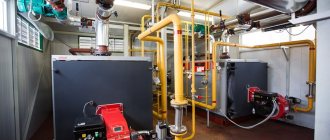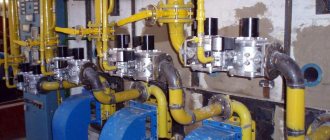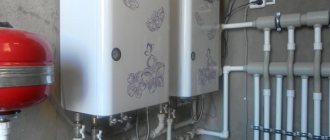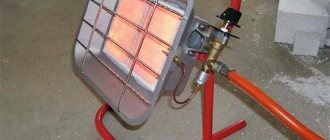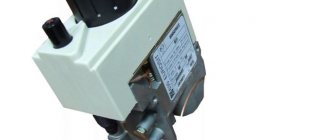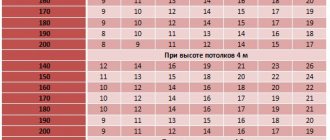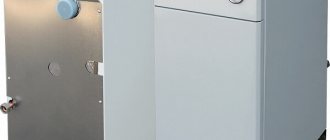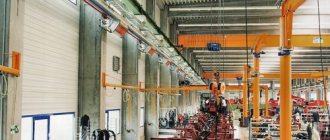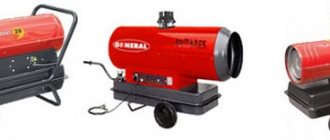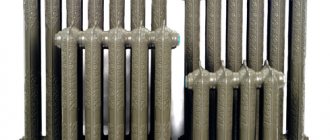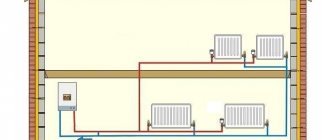Why do you need a smoke exhauster?
- automate the boiler operation process by turning off the smoke exhauster when the set temperature is reached and turning it on when the temperature drops below the established norm, which eliminates constant human supervision of the boiler;
- eliminate black smoke from the chimney, as well as soot and soot because a smoke exhauster, like a forge in a forge, sharply increases the amount of oxygen in the firebox, which ensures complete combustion of coal;
- increase the boiler power and increase the boiler efficiency;
- prevent smoke from entering the room, because it creates a vacuum in the boiler, so it does not smoke. To avoid smoke when loading coal, you must turn on the smoke exhauster;
- allow the stove to fire in any weather, even when there is no draft, because they force air into the boiler;
- used to replace blower fans in order to eliminate smoke in the boiler room and increase its efficiency;
- if a smoke exhauster is used that creates a high air flow rate (especially at 3000 rpm), then this contributes to the self-cleaning of the heat exchanger - the abrasive effect of smoke with small particles.
After installing a smoke exhauster, the temperature in the boiler furnace rises sharply due to the supply of a sufficient amount of air for complete combustion of the fuel (including tar and soot), black smoke disappears from the chimney, and cleaning of both the boiler itself and the chimneys is required much less frequently.
Features of using smoke exhausters
When choosing a traction smoke exhauster, you need to calculate the cross-section of the exhaust pipe and the power of the exhaust unit. Unlike pressure units, they are more versatile and efficient, they allow you to add firewood while the boiler is operating, and prevent combustion products from entering the room.
Forced exhaust of combustion products will help make your stay in the room safe and reduce the risk of carbon monoxide poisoning to a minimum.
The use of smoke exhausters for pellet burners or boilers running on sawdust or peat is the only possible way to organize the heating process. Under normal conditions they burn poorly.
Advantages of using a chimney hood:
- Improving the efficiency of heating devices, firewood burns with virtually no residue;
- Eliminates the accumulation of smoke in rooms, eliminates unpleasant odors;
- Exhaust gases do not flow back into the room when the firebox door is open;
- Reduce deposits on the walls of chimneys due to the filtration and separation system.
They have practically no disadvantages. If no errors were made during installation, the service life of the smoke exhauster in the chimney is comparable to the service life of the boiler itself. In this case, regular maintenance must be carried out.
What power is the smoke exhauster needed?
This depends on the power of the heating boiler in which it is installed:
- DS-1.9-170-220 for boilers with power up to 40 kW;
- DS-2.2-370-380 for boilers with power up to 80 kW;
- DS-2.7-750-380 for boilers with power up to 180 kW;
- DS-3.8-1500-380 for boilers with power up to 300 kW
When smoke exhausters are connected in parallel to the chimney, two DS-3.8-1500-380 are suitable for a boiler with a power of up to 600 kW, and two DS-2.2-370-380 are suitable for a boiler with a power of up to 160 kW.
Types of smoke exhausters
When the chimney shaft built in a building does not provide sufficient draft for normal operation of the heating device, then you should try to solve the problem using a simple and inexpensive smoke exhauster. If natural traction is still not enough, then you should pay attention to electromechanical devices.
Options for offered devices
:
- Draft amplifiers are devices whose main structural element is axial fans that increase natural draft. They are installed at the end of the exhaust pipe or shaft. The performance of the equipment is adjusted manually.
- The supply exhaust fan for the boiler is mounted on the inlet pipe of the heating equipment. The device has the following design: the impeller is located inside the smoke channel, without blocking its cross-section; outside there is an electric motor and other parts. Thus, the smoke is removed through the shaft using natural draft, and the smoke exhauster is operated as needed. Automatic and manual control is possible.
- A centrifugal traction machine is capable of creating high pressure and vacuum in the combustion chamber. Under such circumstances, any chimney will begin to operate. It is recommended to install the equipment in such a way that the control of all elements of the system is tied to the electronic unit of the boiler. In this case, the operation of the devices will be consistent.
Example of a domestic smoke exhauster
In the case of high-power heating equipment, it is recommended to install a blower ventilation system with a pair of fans. Just remember the importance of correctly calculating the power of the smoke exhauster and blower. This will ensure balanced operation of the system.
When choosing a smoke exhauster, also pay attention to the fact that the devices are produced for solid fuel, pyrolysis and gas boilers. However, they have significant design differences.
How does a smoke exhauster work?
The smoke exhauster, drawing flue gases from the boiler, creates a vacuum in it and thus air enters the furnace through the grate for burning coal or other solid fuel. This prevents the flow of smoke from loosely closed firebox doors when the seals wear out.
A powerful air flow quickly ignites the boiler and the required coolant temperature is reached, after which the smoke exhauster turns off. If the boiler has a smoke exhauster, the length of the pipe does not affect the draft.
When the smoke exhauster turns off, coal combustion will slow down and the temperature of the coolant will begin to drop. The smoke exhauster will turn on again when the coolant temperature drops below the set value and the process will repeat again.
When should you buy a smoke exhauster?
Heating equipment has its own fans, which are needed due to the high resistance of the heat exchanger - the gas changes the direction of its path in the flame tubes. A fan is installed to remove heat from combustion products and increase the efficiency of the heating device.
The forced exhaust that comes with the boiler is configured for combustion in this equipment and is controlled from the remote control. If a fan is installed on a device without a computer, then their operation will not be synchronized.
To coordinate the work, you need to buy automation or set the speed yourself.
In what cases is a smoke exhauster necessary to improve operation and simplify boiler maintenance:
- if there are problems with draft, when the wind blows, air pockets appear, there are many turns in the chimney, the diameter narrows;
- smoke from the boiler enters the room when the door is opened;
- the chimney is low or the top of the chimney is in the area of wind pressure, covered by another building or ridge;
- there are cracks in the brick pipe through which smoke escapes.
It is useless to buy a smoke exhauster if there is no air flow from outside. Immediately after installation, the wings will discharge the air a little, but then they will simply knead it in place.
Air supply is the key to proper operation of the heating installation.
Some solid fuel boilers may release smoke through the loading door when it is open. The same phenomenon can be seen in three-pass heating systems in fire tube heat exchangers with high resistance.
There is only one solution - install a smoke exhauster with automatic control or normalize the draft.
There is also a disadvantage to installing forced ventilation. If a chimney hood is not installed, the device cannot be turned off, otherwise carbon monoxide will accumulate in the room.
This is dangerous in the event of an unexpected power outage.
Therefore, forced ventilation is not forever; it should not replace natural draft, but only help in cases where something interferes with it. Therefore, if there are difficulties, the causes of interruptions in traction should be eliminated.
How to install a smoke exhauster?
Where should I install it?
According to the project. If it is not there, then it is recommended to install a smoke exhauster in the boiler room in close proximity to the boiler. It is not recommended to install a smoke exhauster outdoors, because... precipitation can lead to corrosion of the smoke exhauster because Flue gases contain sulfur oxide and nitrogen oxide, which leads to the formation of nitric and sulfuric acid when condensation is formed from atmospheric air.
Install the smoke exhauster according to the figure at points 7-10. The outlet pipe can be rotated in 45° increments and is connected to the chimney pipe tee on the side so that soot and condensate from the pipe do not enter the smoke exhauster, but flow through the condensate drain.
How to build a homemade smoke exhauster for a boiler
Stable and economical operation of solid fuel boilers is ensured by good draft. With strong draft, the fuel burns out completely, and there are no unpleasant odors of combustion products in the heated room.
Typically, traction is provided by natural exhaust. If it is not enough, they resort to the help of special exhaust machines and smoke exhausters. You can make a smoke exhauster with your own hands, it’s not difficult.
You can make such a smoke exhauster yourself
Classification of smoke exhausters
Before installing the exhaust machine, you can try to do without it, increasing the draft with special devices that do not require forced air distillation and energy consumption. Sometimes an extended pipe or installing a deflector on the top helps. If the problem cannot be resolved, you can use:
- natural draft enhancer;
- flow exhauster;
- centrifugal exhaust fan.
The first of them consists of a fan mounted on the top of the chimney and connected to a control panel. The simplest and cheapest option, but its performance is low. Smoke exhausters come in several types
In the second design, the hood housing with the impeller is placed in the smoke duct, and the electric motor is installed outside. This configuration allows the use of engines and turbines of any power.
The highest performance of a centrifugal smoke exhauster. This design allows you to service chimneys with the most complex configuration and large cross-section.
Interesting: DIY chimney.
In this video you will learn how to make a smoke exhauster:
Features of use
In solid fuel boilers, such types of fuel are often used that it is impossible to do without a forced increase in air supply - sawdust or peat burn poorly without blowing. A complete heating process here is only possible with the help of a smoke exhauster.
The hood, unlike pressure units, allows fuel to be supplied to the boiler continuously, which increases its performance and prevents gaseous combustion products from penetrating into the room.
Use of hoods:
- improves the efficiency of boilers, leads to complete combustion of firewood;
- prevents the accumulation of smoke in residential premises, eliminates unpleasant odors;
- prevents the return of exhaust gases into the room when the door is open;
- reduces the amount of deposits on the walls of chimneys;
- With proper installation and regular maintenance, the service life of the smoke exhauster can be equal to the duration of use of the boiler.
Useful to know: what kind of wood is best to burn the stove with.
Specifications
Not only factory-made hoods can be installed in the chimney. If desired, it is not difficult to install a homemade smoke exhauster. In order not to make a mistake when purchasing or manufacturing components of a mechanism, you first need to familiarize yourself with its technical parameters.
The design of the smoke exhauster consists of:
- housing or casing for the impeller made of heat-resistant steel, the thickness of the sheets of which is not less than 1.5-2 mm;
- an AC electric motor installed outside the impeller housing, this arrangement increases its service life;
- a shaft connecting the engine to the impeller and mounted on bearings with hermetically sealed seals;
- inlet and discharge pipes and dampers;
- ash collection bunker;
- impeller (impeller), material of manufacture - alloy steel.
The metal must withstand temperature loads of up to 300° C and the aggressive effects of hot gas exhaust. Before installation, careful balancing is necessary to prevent excessive vibration, leading to premature wear of the mechanism. Impellers can be bladed or centrifugal.
Exhaust parameters for solid fuel boilers consist of:
- electric motor power;
- productivity (calculated in 1 m³/h);
- created pressure.
It will be good if the resources of all indicators of the unit are higher than those required by operating conditions. This increases the reliability of the machine.
Homemade designs
You can make smoke exhausters for boilers with your own hands. This will save you money on buying a factory hood. To fold such a machine yourself, you only need to purchase an electric motor. The remaining components can be made from available materials.
By making such a pump yourself you will save your money
Hood from scrap materials
The set of tools required for work consists of:
- Bulgarians;
- welding machine;
- drills;
- metalworking tools;
- hammer;
- rulers;
- caliper.
Work begins with the manufacture of an exhaust fan. The impeller, matched to the size of the exhaust pipe, is secured to the motor shaft. The engine, using fasteners equipped on its body, is placed in the pipe.
To make a smoke exhauster you will need at least. Bulgarian
After connecting the motor to the wiring, during the first test run it is necessary to check the direction of the air flow and, if necessary, adjust the operation of the rotor.
The pipe for placing the turbine is selected with a diameter 2-3 cm wider. Its length should extend beyond the fan by 3-5 mm. One end of the pipe is welded with a lid, a hole is made in the center for the chimney, and another one is equipped on the side, to which the outlet pipe is attached.
During operation, the fan should not cause increased vibration of the hood body. To prevent this from happening, it is installed using bushings to center the bearings.
The hood assembly is completed by welding the back cover to the pipe and attaching the motor to the stand. After connecting the air ducts and electrical wiring to the unit, it is ready for use.
Intermediate option
If the option with a factory product seems too expensive, but you want to reduce the time it takes to create it yourself, you can use an intermediate option .
To do this, you need to purchase the main components of the structure in the store - an electric motor and a cooling impeller. Then make the hood body from the pipes yourself.
This is done in the same sequence and with the same tools as when performing the economy option.
This option for assembling a drawing machine does not require special alignment of the impeller, which is a rather delicate and complex job for a non-professional. A factory-assembled mechanism is usually already centered and only requires checking during trial operation.
Maintenance and operation
To extend the service life of the unit, it is necessary to reduce the effect of moisture on it , an increased level of which leads to premature corrosion of not only the metal parts of the machine. The easiest way to protect against precipitation is to install a deflector on the top of the pipe.
To ensure reliable operation of the motor and fan, their rubbing parts are regularly lubricated and cleaned.
It will be easier to maintain the boiler if you connect it to the control of the heating and ventilation system.
In order to make a smoke exhauster for a boiler with your own hands, you just need to prepare a set of necessary tools and have a desire to save money. After all, a homemade smoke exhauster costs much less than a factory-made one.
How to regulate the coolant temperature with a smoke exhauster?
How often should it be turned on? Can a fireman do this manually?
The operating mode of the smoke exhauster depends on the boiler power and the ambient temperature in winter. The operating time can be 5-10 minutes and it will not work for several minutes while the temperature drops.
This can be done manually by a person, but the use of a thermostat allows you to fully automate the maintenance of the temperature of the coolant leaving the boiler set by the operator.
Boiler automation produced by BAGAN
Why do you need a smoke exhauster?
So, everything is clear with the fan structure. Now we can talk in more detail about the purpose of the smoke exhauster. In fact, there are several smoke exhausters, because such a device is universal. They are installed in almost all areas of heating systems.
Diagram of body rotation angles.
Smoke exhausters occupy a central place in almost all boiler rooms. This is due to their structure and properties. Of course, such units, which have low power, can also be used in industrial enterprises.
Equipment of this type is installed not only on large, but also on small water heating boilers. They can be used in almost all types of boiler rooms known to mankind. However, the work of smoke exhausters is not limited to this area. Due to their versatility, they can be used in other sectors of the national economy where it is necessary to remove smoke from a room or from units.
How to connect it to the mains voltage.
The smoke exhauster is connected through a thermostat, which controls the temperature of the coolant leaving the boiler and periodically turns on the smoke exhauster when the coolant temperature drops, and then turns it off when the set temperature is reached.
The smoke exhauster can be connected through the standard boiler control unit when replacing the blower fan with a smoke exhauster, if their powers are the same.
If the power of the smoke exhauster is greater, then the electrician must connect it through a contactor of the appropriate power. If such a unit is not available, you must purchase a device that is available from our company.
Connecting the electric motor.
The power cable must be connected using cable lugs only. Use cable lugs of the appropriate cross-section to prevent overheating of the cable connection to the winding terminals. The cable to the terminal box must be connected without tension, and the contact connections must be securely tightened.
Motor protection.
Each electric motor must be protected against overload and short circuit. The settings of the protection devices must correspond to the operating mode of the electric motor, as well as its characteristics.
Short circuit protection is carried out using fuses or circuit breakers (the second option is more preferable, as it eliminates the occurrence of a “phase loss” mode). When choosing an automatic machine, it is necessary to take into account that the starting current of an asynchronous electric motor with a short-circuited winding is 5–7 times higher than the rated one.
Thermal protection must be time-delayed and can be achieved using a thermal relay.
If the engine has built-in temperature sensors, they must be connected.
Attention! Short circuit protection must be implemented in any case, regardless of whether there is built-in temperature protection or not.
Electric motor maintenance.
1. Checking the degree of contamination of the outer surface.
As well as the fan and engine protective casing. If the housing is dirty, remove the dirt using a rag or soft brush. Use compressed air to remove dust or chips from the surface of the engine, as well as from the ventilation unit.
2. Checking the temperature of the bearing units and motor housing.
3. Checking the vibration level of electric motor components.
If you have the appropriate measuring instruments, perform vibration diagnostics of the engine bearing units to determine their technical condition and make a decision on repairs.
4. Check the degree of wear of the shaft seals.
While the engine is stopped.
5. Checking the motor insulation resistance.
While the engine is stopped.
6. Check the tightness of all bolted connections.
Including the connection of the power cable and motor terminals (first make sure that there is no voltage applied to the motor).
7. Visual external inspection of bearing units.
Make sure there are no grease leaks.
The principle of operation of the smoke exhauster
Block diagram for a smoke exhauster.
Before you get started, it’s worth getting to know this device a little better. As for the structure of the unit, it is quite primitive. There is a guide apparatus with a suction funnel. Also, the design necessarily includes an impeller, firmly attached to the engine. The cochlea is a housing through which the exhaust air will be discharged outside.
The principle of operation is that due to the rotation of the smoke exhauster, a suction vacuum is formed. As a result, all gases, smoke, dust or aerosol are sucked into the cochlea. It is through it that the exhaust air is removed to the outside.
Will the smoke exhauster burn out, what temperature can it withstand?
Smoke exhausters from other manufacturers operate at temperatures up to 200°C. They need to be cooled - placed outside. Since tar from flue gases condenses at temperatures below +80°C, in the cold season tar actively condenses on a cold impeller and soot adheres. The fouling of the impeller with dirt always ends with it jamming and the electric motor burning out.
The difference between smoke exhausters produced.
Our smoke exhauster can withstand higher flue gas temperatures.
We have developed and are producing smoke exhausters that can/should be installed immediately behind the boiler in a warm boiler room. As a result, the impeller is hot and dry all the time, nothing sticks to it. The temperature on the impeller reaches 150-400°C (much higher than the condensation temperature of the resin) - the resin and soot “evaporate”.
The usual temperature of flue gases is 150-250°C and the smoke exhauster must operate for a long time at these temperatures. The smoke exhauster operates stably at flue gas temperatures up to 350°C, and can withstand temperatures of more than 400°C for a short time, but such high temperatures can lead to the impeller steel burning out, i.e. corrode, become thinner and break down. To work in chemically aggressive environments and high temperatures, it is necessary to order smoke exhausters made of stainless steel.
Our smoke exhausters solve the problem of transferring and effectively removing heat from a hot impeller to the rotor shaft of an asynchronous electric motor. The impregnation of the motor winding does not dry out - the winding does not burn out.
ATTENTION: Monitor the temperature of the flue gases leaving the boiler!
Since our segment of the smoke exhaust market is low-power boilers, where there are many home-made boilers, we constantly remind homeowners of the need to install a thermometer on the chimney immediately after the boiler (before the smoke exhauster). Contamination of the heat exchanger means increased fuel consumption accompanied by an increase in the temperature of the flue gases at the boiler outlet. The impeller of a switched-off smoke exhauster may become severely overheated—it will become deformed.
Timely cleaning of the boiler means saving on fuel. Tired of cleaning your boiler often? Make a complete boiler piping - install a three-way valve and a bypass! Rapid contamination of the heat exchanger is facilitated by improper starting of the boiler and its prolonged operation with a “cold” coolant (condensation of resins on the walls of the heat exchanger)…
Device Features
Basically, all smoke exhausters that are present on the modern market can be produced in two versions, namely right and left rotation. In some situations, it can be quite difficult to determine which way the wheel is turning. However, any specialist can cope with this task.
First you need to approach the unit from the engine side. From here you should be able to see in which direction the impeller rotates. Left rotation is counterclockwise, and right rotation is clockwise. The angle of rotation of the snail can be varied. It varies from 0 to 270°. The rotation interval is – 15°.
Installation diagram of the smoke exhauster.
So, determining the direction of rotation is quite simple. Sometimes there are cases when, during an incorrect connection, the unit begins to work incorrectly, that is, it does not pull smoke out of the room, but drives in all the worst things from the environment. This is simply unacceptable. This problem can be solved quite simply. It is worth switching the phases either on the circuit breaker or directly on the motor. That is, you simply need to swap them.
Sometimes stiffening ribs interfere with the operation of smoke exhausters. In this case, some of them can simply be deleted. This is done mechanically.
Visual inspection and maintenance of the units must be carried out through special hatches or openings located on the volute. During operation, condensation may accumulate in the fan. Of course, you need to get rid of it immediately. Fortunately, the design of modern units provides for the presence of special drain holes on the volute. Excess moisture is removed through them.
If large bearings are installed in the smoke exhauster, then it will serve faithfully for many years.
Smoke exhauster impeller.
The wear and tear of such units is insignificant. Often, collapsible bearings are used in such smoke exhausters. This is done to ensure that their maintainability is at its best. Large units are quite difficult to work with, but if they are understood, then this will not be a problem.
Some smoke exhausters or fans get quite hot. This also applies to large units. In this case, they can be equipped with an additional cooling coil. Today, many manufacturing companies offer this additional option.
Can an electric motor burn out?
If it can burn, then why?
The smoke exhauster has an asynchronous motor, which can be connected to a 220 or 380 Volt network.
It is connected to a 380 V network by a star, and to a 220 V network through a capacitor of the appropriate rating (which depends on the engine power) by a specialist electrician. The connection to the 380 V network must comply with the requirements of the “Operation Manual for Asynchronous Motors”.
To prevent the electric motor from burning out during operation, it is necessary to install protection against overload and short circuit.
The settings of the protection devices must correspond to the operating mode of the electric motor, as well as its characteristics. Short circuit protection is carried out using fuses or circuit breakers (the second option is more preferable, as it eliminates the occurrence of a “phase loss” mode). When choosing a machine, it is necessary to take into account that the starting current of an asynchronous electric motor is 5–7 times higher than the rated one.
Thermal protection must be time-delayed and can be achieved using a thermal relay.
The use of “cheap” contactors for switching on, which are characterized by “sticking” of the contact in one of the phases, is the reason for the combustion of the electric motor during operation.
The operating instructions for asynchronous motors used on BAGAN smoke exhausters are posted in the documentation section at the link.
Classification of smoke exhausters
Before installing the exhaust machine, you can try to do without it, increasing the draft with special devices that do not require forced air distillation and energy consumption. Sometimes an extended pipe or installing a deflector on the top helps. If the problem cannot be resolved, you can use:
- natural draft enhancer;
- flow exhauster;
- centrifugal exhaust fan.
The first of them consists of a fan mounted on the top of the chimney and connected to a control panel. The simplest and cheapest option, but its performance is low.
In the second design, the hood housing with the impeller is placed in the smoke duct, and the electric motor is installed outside. This configuration allows the use of engines and turbines of any power.
The highest performance of a centrifugal smoke exhauster. This design allows you to service chimneys with the most complex configuration and large cross-section.
RELIABILITY OF BAGAN SMOKE EXTRACTORS.
During the production of smoke exhausters, each impeller is balanced on a rotating electric motor rotor (about five minutes). This way we eliminate beats and resonances, and at the same time check the quality of the electric motors themselves.
We use only asynchronous motors with a long guaranteed service life (at least 10,000 hours) - they should last at least 2-3 years of operation. During operation during this period, only wear of the bearing or combustion of the winding is possible due to incorrect connection, without a protection device, or electrical power.
| HEAT-RESISTANT SMOKE EXTRACTORS “BAGAN” | |||
| Product Catalog | |||
What is the efficiency of a solid fuel boiler?The efficiency of a solid fuel boiler is often indicated as 90% or higher. It is difficult to obtain such a high efficiency, much less an official document confirming it. To do this, it is necessary to carry out special tests, since conventional fuel, in terms of its characteristics and composition, is very unstable... Read the article... |
Why do you need a three-way valve?The main purpose of a three-way valve. In relation to a solid fuel boiler, its function is to maintain a high temperature of the boiler to reduce the condensation of resins on its inner surface. This ensures the required temperature of the coolant used for heating by mixing hot boiler water with low-temperature water supplied back from the consumer... Read the article... |
Which boiler is better?One that doesn't create problems for us. Which you can forget about and not remember, because... it heats without “dust and noise” and doesn’t even smoke. In which the coal itself pours from the hopper onto the grate and burns, without hanging up, becoming coked. Which will not go out, will not wake you up at four o'clock in the morning with the cold in the winter cold. A boiler whose grates do not burn out and which itself maintains the temperature. And it is important that the coal bunker is large at the boiler. So that it does not boil, the seams do not burst and water does not suddenly leak out. And the most important thing is that you don’t have to constantly clean it of tar and soot! Such a brief technical specification for the development of the boiler was formulated during its design... Read the article... |
Calculation of the required power of a hot water boiler.A hot water boiler is installed not only to heat the coolant in the heating system, but also to supply hot water to housing. To determine the required boiler power, it is necessary to separately consider each of the connected systems (circuits): — radiator heating - warm floor - hot water for domestic needs Read the article... |
Making a smoke exhauster with your own hands
If you wish, you can assemble such a device yourself from scrap materials.
We only need an electric motor. Everything else can be made independently, although it is better to purchase a factory-made impeller, even if it is used. Tool you may need:
- Bulgarian;
- Welding machine or inverter;
- Drill, plumbing tool, hammer;
- Ruler, caliper.
The easiest way to manufacture is an exhaust fan, which will be installed inside the pipe. To do this, you will need a small electric motor with a power of up to 1 kW and a suitable impeller with blades. It is mounted on the motor shaft, and its housing is equipped with fasteners for placement in the pipe
When connecting the wiring and first start-up, pay attention to where the air flow will go
A self-made smoke exhauster for a solid fuel boiler can be seen in the following video.
A design with a volute and a centrifugal fan will be more complicated. The procedure for its manufacture is as follows:
- For a ready-made turbine, we select a piece of pipe with a diameter 2-3 centimeters larger. Cut it to the size of the fan plus 3-5 mm;
- We cut a hole on the side for the outlet pipe, and weld a lid to one of the ends with a hole in the center for the chimney from the boiler. The incoming flow will be perpendicular to the outgoing one; with this scheme, the electric motor is located horizontally;
- The most critical stage is the installation of the shaft and fan. For accuracy, you can use bushings for centering and pressing the bearing. When the engine is turned on, beating and vibration are unacceptable.
- We weld or screw the back cover and install the engine on the stand. We connect air ducts and electrical wiring.
How to properly install a smoke exhauster on a fuel boiler
Here are some tips:
- If there is a separate room for the boiler, then the hood is mounted in it for ease of maintenance;
- It is advisable to place powerful chimneys outside the house due to the loud noise during operation;
- The electric motor is protected by a separate circuit breaker, and its control is conveniently transferred to the general heating system control panel;
- There must be free access to the smoke exhauster for cleaning.
Cost of installation of a smoke exhauster
For homemade products, the price is determined by the cost of the electric motor and impeller. The cost of a three-phase electric motor with a power of 0.18 kW starts from 1950 rubles, the simplest blade impellers - from 350 rubles. Add to this the purchase of wires and small accessories. There will be benefits if you can get a used engine.
A ready-made smoke exhauster costs a little more. So, for a device with a capacity of 2000 m3 per hour you will have to pay from 14,000 rubles for an unknown manufacturer to 23,500 for a smoke exhauster from the Wirbel company. Simple blade units cost inexpensively 6-8 thousand rubles. If the installation of a smoke exhauster on a solid fuel boiler is carried out by a specialist, then for the work and turnkey connection you will have to pay up to the cost of the pump itself, depending on the complexity.
